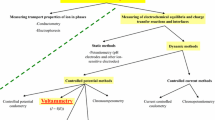Summary
A rapid procedure for the concentration of highly diluted aqueous solutions containing traces of phosphorus (down toca. 0.0025 p. p. m.) is described. The method is based upon (a) selective carrying of P(V) by ignited BaSO4 or SrSO4 in presence of a suitable charge determining cation, (b) stripping the carried phosphorus quantitatively in small volume of HC1 solution. The phosphorus concentrate is then spectrophotometrically determined by the molybdenum blue method, and the amount of the trace element in the original sample is estimated by applying a radiometric correction factor. Conditions have been worked out for applying the method in presence of the following interfering ions: As(III) (400 p. p. m.), Al3+ (200 p. p. m.), Fe3+ (200 p. p. m.), and over 1000 p. p. m. of each of Ca2+, Mg2+, Cu2+, Mn2+ and Cr3 ions. The net recovery (uncorrected) of phosphorus in the concentrated form comes toca. 98–99%, and the net error of estimation after correction can be minimised to the limit of accuracy of spectrophotometric determination.
Zusammenfassung
Die rasche Anreicherung von Phosphorspuren (zirka 0,0025 ppm) aus hochverdünntea wäßrigen Lösungen wurde beschrieben. Sie beruht a) auf der selektiven Adsorption von P(V) an geglühtes BaSO4 oder SrSO4 in Gegenwart eines geeigneten Kations; b) auf der quantitativen Überführung des adsorbierten Phosphors in ein kleines Volumen Salzsäure. Der angereicherte Phosphor wird dann nach der Molybdänblaumethode bestimmt und die Menge des in der ursprünglichen Probe enthaltenen Spurenelementes mit einem radiometrischen Korrekturfaktor ermittelt. Die Arbeitsbedingungen bei Anwesenheit der störenden Ionen As(III) (400 ppm), Al(III) (200 ppm), Fe(III) (200 ppm) und über je 1000 ppm Ca, Mg, Cu(II), Mn(II) und Cr(III) wurden ermittelt. Die unkorrigierte Ausbeute an Phosphor in der angereicherten Form beträgt etwa 98 bis 99%, der Fehler nach der Korrektur entspricht der Genauigkeitsgrenze der spektrophotometrischen Bestimmung.
Similar content being viewed by others
References
G. H. Lueck andD. F. Boltz, Analyt. Chemistry30, 183 (1958).
N. H. Furman (ed.), Standard methods of chemical analysis, 6th ed., vol.I. Princeton: Van Nostrand. 1962. pp. 148, 996.
K. R. Kar andB. C. Sawhney, J. Sci. Industr. Res.18 B, 106, 144 (1959).
D. F. Boltz (ed.), Colorimetric determination of non-metals. Interscience. 1958. pp. 32–33.
K. R. Kar andGurbir Singh, Mikrochim. Acta [Wien], in press.
K. R. Kar andM. M. Bhutani, Indian J. Chem.1, 3 (1963).
K. R. Kar andM. M. Bhutani, J. Sci. Industr. Res.21 B, 280 (1962).
A. N. Bhat andB. D. Jain, J. Sci. Industr. Res.19 B, 295 (1960).
Author information
Authors and Affiliations
Rights and permissions
About this article
Cite this article
Kar, K.R., Bhutani, M.M. & Singh, G. Chemical separation and determination of traces of phosphorus. Mikrochim Acta 56, 1198–1203 (1968). https://doi.org/10.1007/BF01224419
Received:
Issue Date:
DOI: https://doi.org/10.1007/BF01224419




